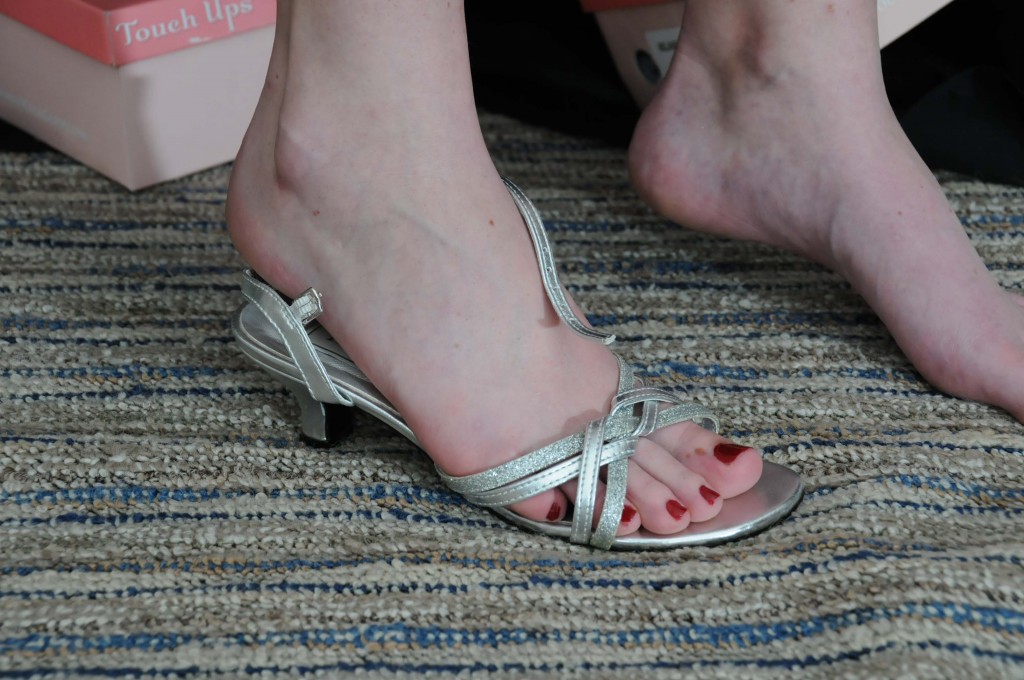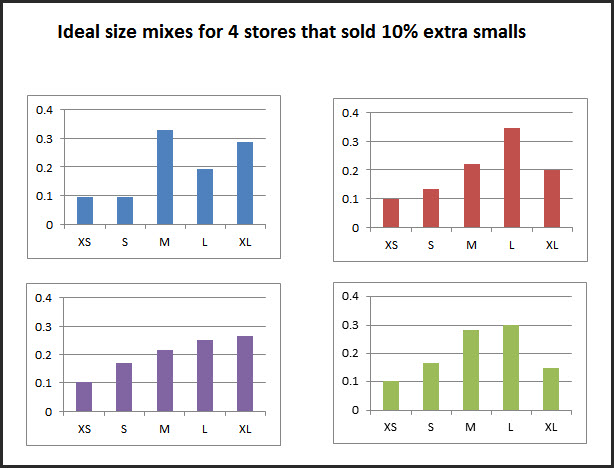How to Determine a Stores Ideal Size Mix
When it comes to ideal size mix, you do not need to be precise about the size mix you send every one of your stores–only the stores in which you want to maximize profit.
If youre interested in maximizing a stores profitability, you must send them the sizes their customers need. Anything else creates lost sales in the sizes needed and markdowns in the sizes the stores customers dont need.
In If the Shoe Doesnt Fit, There Is No Sale, youll see that each store has its own unique and precise ideal size mix, and that these ideal size mixes dont generally follow a smooth curve. This is depicted below by four stores that sell a large percentage of XS (10%) whose size mixes are totally different and not necessarily smooth or intuitive.
- Size mix is vital to profitability.
- Each store has its own unique and precise ideal size mix.
- Size mixes do not follow a set pattern, meaning you cant predict how XLs will sell based on knowing how XSs sell).
How do you determine each stores ideal size mix?
Each store has multiple size scales. Ideal store level size mixes vary by merchandise category and season.
For instance, the ideal size mix is different for t-shirts than for dress shirts, sweaters and jackets. Different people are buying them and the fit for each category is somewhat different, as well.
The size scales for a given merchandise category also vary by season. While this is true regardless, it is exaggerated by stores that have demographic changes throughout the year, such as Florida in the winter or in tourist destinations during high-season. The seasonal demographic difference also can be exaggerated during the holiday season when people are buying gifts for others who are not patrons of the store .
That means you need to determine what the stores ideal size mixes are by merchandise category and by season.
Five Methods of Determining Ideal Size Mix
Here are 5 methods of determining a stores ideal size mix, in order from the best/most accurate to the least:
- From Basic Stock Items or never out items
This is not only the best/most precise method, its also the easiest. What youre looking for is decent selling merchandise that always has every size in stock. The size mix is simply the sum of the sales for each size over a representative period of time. If the size run gets broken at some point, the lost sales will make some sizes look a little lower than they should be, but, generally this works pretty well.
- From a Data warehouse
This is essentially the same as the first method, using basic stock items or never out items. The thing about this method is that the incidence of size runs being broken and lost sales is quite a bit higher. Again, this will tend to make some of the better selling sizes not look as good as they really are.
- From Season to Date Sales
This could be easily based on any other time period for which youve captured size level sales. In the Island Pacific retail system, Season to Date Sales are always captured at the size level. The down side of this method is that there is a self-fulfilling prophecy phenomena going on. Sooner or later, the sizes you distribute to the stores are the sizes youll sell. Accordingly, this method is even more susceptible to being skewed by unaccounted for lost sales of better selling sizes.
These factors can be mitigated to some extent by filtering the items used to determine the ideal size mix. In Island Pacific, the items used can be filtered to only use items that have not been marked down and/or to items that have been distributed to the store in the last two or three weeks. The ideal of the two- or three-week time period is to only use items whose size runs are likely to not have been broken yet.
Filtering the data creates its own issue, however. The more you filter the data, the less data you have from which you can determine size mix. Potentially, you can get into a sparse data issue where you dont have sufficient information to truly determine the ideal size mix.
Although this method seems to have a number of down sides, it is usually a significant step in the right direction. It does improve profits and, as time goes on, it approaches the true ideal size mix more and more.
- From residual sizes when markdowns are taken
This is similar to using the Season to Date Sales method, except in a more manual way. The idea is that if you know how much merchandise you sent to the store by category and size, and you go count the inventory on the markdown rack by size, you can determine how much you sold by size. Obviously, with this approach theres no accounting for lost sales by size, which is likely to be substantial. There also is no filtering.
Still, as limiting as this may seem, this method may be appropriate for getting started with tracking sales by size.
- From an educated guess
This is the least accurate method of determining an ideal size scale. Trying to make an educated guess at what an ideal size mix is like trying to make sense out of airline fares, perhaps even worse. Even the most knowledgeable and intelligent retailer doesnt have the smarts to select ideal size mix.
Instead, go to the data. Anything you can get, do or measure is better than a lucky (or not so lucky) guess.



